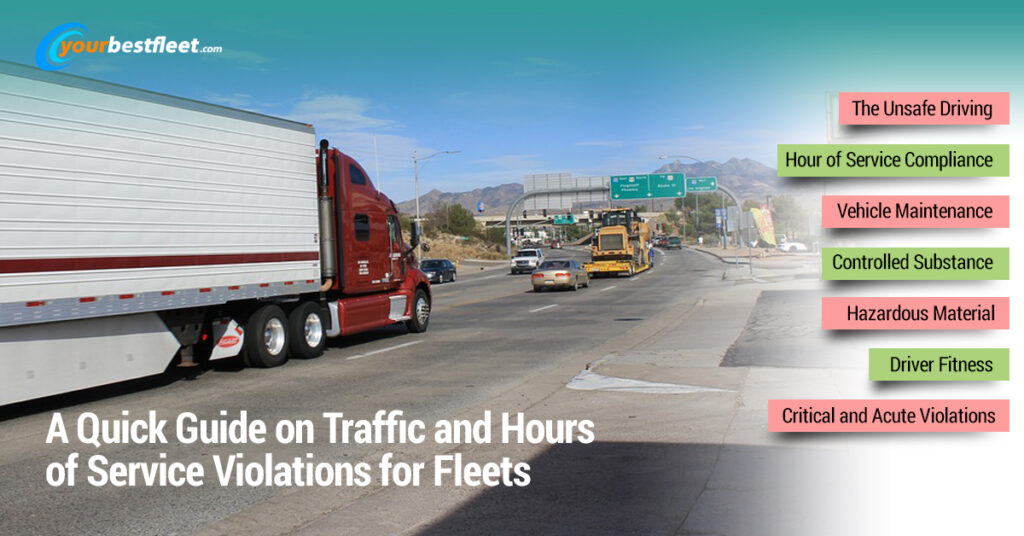The Federal Motor Carrier Safety Administration (FMCSA), working in coordination with the U.S. Department of Transportation (DOT), has introduced rules and regulations for using ELD in commercial vehicles. These devices automatically record Hours of Service and generate electronic reports. Any violations of these regulations can lead to high penalties in terms of fines and suspension of service for a certain period. Commercial vehicle operators must look for solutions to comply with the ELD rule.
This article offers a comprehensive view of modern ELD solutions by leading companies like Matrack Inc. With FMCSA-approved devices, you can comply with ELD rules and create a productivity-inducing system with minimum human intervention. Several ELDs in the market offer solutions to vehicle operators and drivers to remain compliant with the ELD Rule and follow safety regulations with the help of tracking, recording, and reporting facilities, thus ensuring better productivity and efficiency.
Traffic and hours of service violations can completely break fleet operations and result in monetary losses. YourBestFleet brings this guide on traffic and hours of service violations for fleets to help you avoid them.
The FMCSA Regulations
The Federal Motor Carrier Safety Administration (FMCSA) had introduced the mandate(now a rule) to use the ELD in commercial vehicles that can access, record, and share vehicle and driver-related information. It helps monitor risky driving behaviors, road conditions, traffic rules, and safety norms to avoid violations.
It maintains historical records and reports that are mandatory to ensure compliance requirements of fleet operations. The rule says that vehicles must use electronic logging devices to observe safe working practices, record Hours of Service data, and reduce driver fatigue. The main objective of the ELD rule is to encourage safe driving and reduce accidents, crashes, and damages by ensuring adherence to its regulations.
Impact of CSA Scores on Business
Using unapproved ELD or having improper hours of service records can negatively impact the compliance, safety, and Accountability (CSA) score. This score indicates how effectively carriers adhere to safety compliance. It may also restrict drivers’ service for 10 hours in case of violations for:
- not using ELD,
- using unauthorized ELD,
- manipulating log reports.
How to choose the correct ELD device? This ELD buying guide will help you choose the correct ELD device.
These actions eventually lead to more roadside inspections, poor reliability, and loss of business opportunities. CMV and fleet operators obtain scores through frequent road inspections and accident report data from the safety measurement system.
These scores are on a scale of zero to 100. A lesser score indicates better performance. The CSA scores benefit commercial vehicle operators in multiple ways, such as fewer audits and inspections and a better reputation in the transportation sector for ensuring safety. A favorable CSA score helps significantly to improve your operations, profitability, and scope of acquiring more business.
Apart from compliance with government regulations, CSA scores help lower the insurance cost as the possibility of damage and repairs due to accidents becomes less. It is essential to consider the following points that help to achieve the desired CSA score.
- Vehicle Maintenance: Road accidents often are caused by poorly maintained vehicles. According to regulations for violations, damaged headlights and worn-out tires affect the CSA score adversely. Keeping the automobile in good condition by following scheduled maintenance activities can help improve the CSA score.
- Driver’s Competency: It is beneficial to hire drivers with decent safety records so that drivers become more responsible and accountable for safety and compliance. Also, drivers with a good track record can help get a good CSA score in inspection and audit reports.
- Proper Training: It is a good idea to invest in safety training for drivers following national and international standards to avoid unsafe driving practices and minimize the possibility of accidents.
Types of Violations
All Behavioral Analysis and Safety Improvement Category (BASIC) factors determine the CSA score. Each violation has three parameters: violation group description, violation weight, and a comment. The violation description mentions the nature of activities that violate the norms. It contains similar attributes under one group. Violation weight is given based on the probability of accidents and ranges from 1 to 10 depending on the low and high crash risk. The types of violations are classified under six categories as follows:
The Unsafe Driving
This category includes unsafe driving practices like using a mobile phone, improper lane change, lane restriction violations, etc.

Hour of Service Compliance
Commercial motor drivers must adhere to HoS rules. It is necessary to follow only the recommended consecutive hours of driving to avoid fatigue that may lead to accidents. Some of the violations in this category include operating a vehicle under drowsiness, driving beyond specified hours, absence of driver’s duty status record, and no onboard data of duty hours.
Vehicle Maintenance
Maintenance vehicles for trouble-free functioning are essential to avoid safety violations while driving. Specific regulations on maintenance standards apply to trucks that need adherence. The violations include non-compliant headlamps, improper fuel systems, unsafe vehicle equipment, and many others.
Controlled Substance
This regulation is crucial as any violation leads to severe penalties and actions. It refers to drivers’ use or possession of alcohol, drugs, or other controlled substances. The violation rules apply if the driver is found under the influence of drugs or intoxicating beverages within 4 hours of driving or carries drugs or controlled substances.
Hazardous Material
This category deals with the regulations regarding the safe transport of hazardous materials, including loading, unloading, and leakage. Any failure to comply with forbidden material transportation leads to legal actions due to violations.
Driver Fitness
This violation rule considers drivers’ physical and mental fitness and keeps track of records regarding drivers’ medical certificates, safe driving records, and annual reviews. The violations include expired or fraudulent medical certificates, improper CDL and inadequate training of drivers, etc.
Critical and Acute Violations
This type of violation refers to discrepancies found in documents during inspection and audit. These violations require immediate attention and rectification as it is considered a failure in safety control management.
Impact of Violations
The commercial vehicles affected by the ELD rule must know how to comply with the regulation and what penalties they may face in case of violations. If a driver fails to pass the roadside inspection for not having a compliant ELD, the consequence will be as follows:
- A report from the inspector for failing to maintain the record of duty status.
- The driver will remain out of service for 10 or 8 hours if the vehicle is a passenger carrier.
- Once back in service, the driver should complete the current trip using paper logs.
- After completion of the trip, the driver must install and use an ELD before the next trip.
Drivers of commercial vehicles must have basic knowledge of the ELD rule and the implications of violations. Adherence to the maximum consecutive driving hours, production of electronic logs by the device, and keeping a record of Hours of Service are mandatory requirements. It is essential to go through the official documents to understand safety violations and follow procedures to avoid them.
Features of An ELD Ensuring Safety Compliance
Modern Electronic Logging devices like the one from Matrack are FMCSA-compliant and DOT-certified and offer technology solutions to comply with the automated data collection and reporting requirements. These devices offer several benefits to the trucking business by providing ELD-related products and services at an affordable cost helping fleet operators and drivers remain compliant with FMCSA regulations and maintain a good CSA score. One of the best ways to avoid violations is by selecting FMCSA-approved ELDs. The features of ELD that best suit the requirements in line with the rule are as follows.
- Real-time location update: The ELDs track the accurate location and movement of trucks, ensuring better control over safety.
- Accurate reporting: The ELD records data related to HoS, engine diagnostics, and driving performance and prepares accurate reports based on an actual scenario.
- Monitor driving behavior: The ELD helps to monitor and control unsafe driving practices like over-speeding, unwanted idling, or crossing defined boundaries. The device provides information on driving performance that helps control driving performance.
- Vehicle diagnostics: The ELD collects data to prepare reports on engine performance and provide relevant inputs regarding technical issues, and maintenance needs to take proactive actions. It gives predictive indications about vehicle performance and service needs that allow managers to take action to avoid unwanted damages and repairs.
The Role of An ELD in Avoiding Violations
The introduction of the rule has changed operational patterns in the trucking business in various ways. An appropriate and efficient ELD serves the purpose of following regulations, avoiding accidents, ensuring safety, and improving CSA scores. These devices are an effective means to ensure adherence to rules and avoid violations. The various benefits provided by ELD in minimizing traffic and safety violations are as follows:
• Adapting to the New Rule
The Federal Motor Carrier Safety Administration (FMCSA) provides regulations for all commercial carriers to use ELD for their trucks that can record driving hours and maintain electronic logs. These devices are essentially FMCSA-compliant and DOT-certified to keep track of details and maintain records, as required to comply with the regulations. The device helps truckers adapt to the new rule of ELD application with user-friendly and convenient application techniques.
This device allows drivers and business owners to ensure best safety practices and follow HoS rules so that drivers never feel fatigued and contribute effectively with improved performance. The ELD device rule has helped drivers understand the regulations and facilitate compliance.
• Improving Productivity
Truck drivers feel confident and relaxed as the ELD maintains accurate reports on Hours of Service, allowing drivers to follow the specified time limit and work with energy and enthusiasm. The ELD takes care of reporting and maintaining logs as per FMCSA regulations, which allows vehicle operators to concentrate more on other productivity and profitability issues. There is no need for manual intervention and paperwork, which saves time and streamlines the process. It leads to better productivity, resource utilization, and efficiency in operations.
• Increase in Reliability
The ELD rule indirectly improves the capabilities of the trucking businesses as they have to follow safety norms and minimize the possibility of accidents and violations. There is more demand for such vehicles having good CSA scores in compliance and accountability, and the ELD provides solutions in this respect.
The use of this ELD led to higher reliability due to safe practices in handling and dispatching loads for long hauls. It is favorable for the trucking industry as more vehicles adopt ELD applications and improve profitability.
• Organized Workflow
The most significant feature of an ELD is the electronic log generation, which tracks every movement and idle time of vehicles, making the entire system more streamlined and organized.
The ELD generates automated vehicle and driver status reports that provide efficient planning and execution inputs. The hours of service data enable truck owner-operators to utilize the capacity in the best possible way by minimizing delay and detention at any point. In the present competitive scenario, the ELD provides customers with the best service and technology solutions to optimize workflow.
• Reduced Insurance cost
The ELD allows trucking companies to become more efficient in maintaining safety and compliance. It keeps track of driving performance and safety practices to avoid violations. The accurate reports guide managers to follow the desired hours of service and ensure better driving standards that help to minimize accidents and violations.
This report creates a base for the compliance, safety, and accountability (CSA) score of trucks given by FMCSA. Insurance companies always look for customers with good CSA scores and reliability. It helps drivers adhere to safety rules and minimize the possibility of damages and repairs, which lowers the insurance premium. This ELD helps significantly reduce the chance of accidents, collisions, and on-the-road safety violations.
Conclusion
The ELD rule has driven several truck operators to upgrade to an ELD-compliant fleet tracking system that helps them stay safe, efficient, and compliant. The primary purpose of identification of violations and taking action is to avoid unsafe practices and non-compliant operations that might lead to accidents. Electronic Logging Device from Matrack provides reliable support in maintaining better control over fleet operations by proactively resolving technical issues, controlling driving behavior, and tracking drivers’ duty hours.
Frequently Asked Questions
What are the consequences of traffic violations?
A: The consequences of traffic violations can include fines, points on the driver’s license, and increased insurance premiums. Repeat offenders may also have their licenses suspended or revoked.
What are the consequences of hours of service violations?
A: The consequences of hours of service violations can include fines, points on the driver’s license, and increased insurance premiums. Companies may also face fines and penalties for allowing drivers to exceed the maximum hours of service.
How can fleets prevent traffic and hours of service violations?
A: Fleets can prevent traffic and hours of service violations by implementing driver training programs, using telematics systems to monitor driver behavior, and enforcing strict compliance policies.
What are some common traffic violations for commercial motor vehicle drivers?
A: Common traffic violations for commercial motor vehicle drivers include speeding, improper lane changes, following too closely, and failing to yield.
What are some common hours of service violations for commercial motor vehicle drivers?
A: Common hours of service violations for commercial motor vehicle drivers include exceeding the maximum hours of service, failing to take required rest breaks, and falsifying logbooks.
How can telematics systems help prevent traffic and hours of service violations?
A: Telematics systems can help prevent traffic and hours of service violations by monitoring driver behavior in real-time, providing alerts for unsafe driving practices, and ensuring that drivers are complying with hours of service regulations.
James Johnson is a former truck driver who now works as a writer, specializing in the trucking industry. With over 15 years of experience on the road, James has a unique perspective on the challenges and opportunities faced by truck drivers and the trucking industry as a whole. His writing focuses on issues such as safety, regulation, and the latest industry trends. His work has been featured in several trucking publications and he has received recognition for his contributions to the industry. In his free time, James still enjoys being around trucks and often attends truck shows and other industry events.


